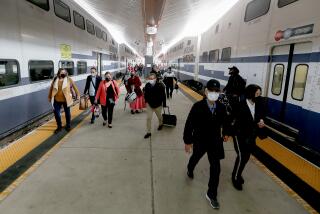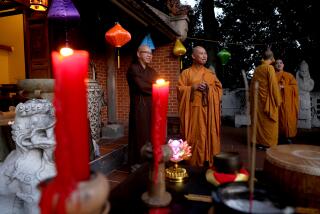A third day of coronavirus surges in L.A. County brings alarm

- Share via
There were new danger signs Tuesday that the novel coronavirus is spreading more rapidly through Los Angeles County as officials reported the third straight day of more than 2,100 additional confirmed cases.
Officials reported 45 more COVID-19-related deaths and 2,779 more cases. Monday brought L.A.’s highest single-day tally, which pushed the county past 100,000 infections.
“The L.A. County community needs to come together again to slow the spread of COVID-19, and we need to act with haste and urgency,” L.A. County Public Health Director Barbara Ferrer said in a statement.
Orange County set its own daily record Tuesday with 779 new confirmed coronavirus cases. The county now has nearly 14,000 cases and 340 deaths.
Gov. Gavin Newsom on Wednesday ordered tougher restrictions on indoor activities for most of the state, marking a major step backward in the reopening and an attempt to slow an alarming rise of the coronavirus in 19 counties.
Orange County reported 56 coronavirus-related deaths last week, its highest weekly death toll since the pandemic began.
California as a whole hit a grim milestone Tuesday when it exceeded 6,000 deaths. That is still far fewer than other coronavirus hot spots such as New York and New Jersey, but the increase in overall case numbers and the stress on hospitals are raising alarms.
The enormous surge in cases, which now total more than 223,900 statewide, has prompted New York Gov. Andrew Cuomo to order anyone traveling to his state from California — and 15 other states that have seen recent surges — to self-quarantine for 14 days.
New York has been among the hardest hit of all states, recording more than 31,000 deaths. New Jersey follows with more than 15,000 deaths, Massachusetts has more than 8,000, and Illinois, Pennsylvania and Michigan each have more than 6,000, according to Johns Hopkins University’s coronavirus tracker.
Health officials have attributed the rising numbers to a combination of factors: the further reopening of many businesses, mass protests over the death of George Floyd and clusters of cases from private gatherings.
L.A. County health officials now estimate that 1 in 140 people are unknowingly infected with the coronavirus, a massive increase since last week’s projection of 1 in 400. With that in mind, Dr. Christina Ghaly, the county’s health services director, said officials were preparing for a surge in hospitalizations and an “increase in mortality” in the coming weeks.
Officials had warned of the possibility of a surge in cases with a resurgence in activity, but they weren’t prepared for the speed at which the jump occurred.
Gov. Gavin Newsom said he planned to announce new restrictions Wednesday, ahead of the Fourth of July holiday weekend.
“We’ll be making some additional announcements on efforts to use that dimmer switch that we’ve referred to and begin to toggle back [to] our stay-at-home order and tighten things up,” Newsom said. “The framework for us is this: If you’re not going to stay home and you’re not going to wear masks in public, we have to enforce, and we will.”
Los Angeles and Ventura counties have announced beach closures for the holiday weekend, and L.A. has added fireworks displays to the list.
Meanwhile, bars across California — many of which only recently reopened — are being forced to again announce last call.
The taps will close Tuesday in Riverside County under a new health order.
“People don’t social distance well after a couple drinks, and it’s one of the hardest environments to trace contacts in,” Public Health Officer Dr. Cameron Kaiser said in announcing the decision. “My hope is that this will be only temporary and further closures won’t be needed, but it all depends on what every one of us as a county do to slow more spread.”
The county had allowed bars to reopen June 12. But Riverside, like many areas of California and the country at large, has seen a worrying surge in coronavirus cases and hospitalizations in recent weeks, forcing officials to slow down or walk back plans to reopen businesses that have been closed during the pandemic.
Restaurants, breweries and pubs that offer dine-in services can still serve alcoholic drinks, but only as part of a meal, county officials said.
Riverside was one of eight counties that the state recently recommended issue local health orders closing bars. The others were Contra Costa, Santa Clara, Sacramento, San Bernardino, Ventura, Santa Barbara and Stanislaus.
Others weren’t given the choice. On Sunday, Newsom ordered seven counties — Los Angeles, Fresno, Kern, San Joaquin, Tulare, Kings and Imperial — to close bars, breweries and pubs that sell alcoholic drinks without serving food at the same time.
In light of the state’s recommendation, Sacramento County has amended its public health order “to take bars off of the list of allowable activities,” officials said in a statement. That revised order went into effect Monday.
Santa Barbara County has done the same. The order there stipulates that brewpubs, breweries, bars and pubs should close starting Wednesday unless they also offer dine-in meals. But wineries and tasting rooms can remain open.
“This action, particularly in anticipation of the holiday weekend, is a proactive measure to curb the spread of COVID-19 locally,” said Dr. Henning Ansorg, the county’s health officer. “We have to keep each other safe during this time.”
Times staff writer Taryn Luna contributed to this report.
More to Read
Sign up for Essential California
The most important California stories and recommendations in your inbox every morning.
You may occasionally receive promotional content from the Los Angeles Times.
















